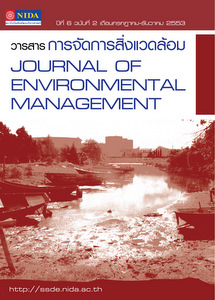ศักยภาพในการลดปริมาณขยะชุมชนจากโครงการธนาคารขยะรีไซเคิล/The Potential of Community Waste Reduction under the Recycle Waste Bank Project
บทคัดย่อ
การวิจัยนี้มีวัตถุประสงค์เพื่อศึกษารูปแบบการดำเนินการ ผลการดำเนินการ ปัญหา และข้อเสนอแนะในการดำเนินงานธนาคารขยะรีไซเคิลของชุมชนทรัพย์สินพัฒนา เขตบางขุนเทียน กรุงเทพมหานคร โดยการสำรวจปริมาณขยะมูลฝอยในครัวเรือนของกลุ่มตัวอย่างที่เป็นสมาชิกธนาคาร ขยะรีไซเคิล 10 ครัวเรือน และใช้แบบสอบถามสอบถามสมาชิก 79 ราย ร่วมกับการสัมภาษณ์เจาะลึกสมาชิก 10 ราย และคณะดำเนินงาน 2 ราย ผลการวิจัยพบว่า ในระยะเวลา 1 เดือน ครัวเรือนมีปริมาณขยะมูลฝอยที่ต้องนำไปกำจัด 182.09 กิโลกรัม จากเดิม 647.79 กิโลกรัม และหากทุกครัวเรือนในชุมชนมีการคัดแยกขยะมูลฝอย จะมีปริมาณที่ต้องนำไปกำจัด 6,828.38 กิโลกรัมจากเดิม 24,292.13 กิโลกรัม ธนาคารรีไซเคิลทรัพย์สินพัฒนามีรูปแบบการดำเนินงานโดยการรับสมัครสมาชิกใน ชุมชน โดยสมาชิกนำขยะรีไซเคิลที่คัดแยกมาฝากขายกับธนาคารขยะ ปัญหาและอุปสรรคที่มีต่อการดำเนินงาน คือ คนในชุมชนส่วนใหญ่ไม่ได้สมัครเป็นสมาชิก เนื่องจากราคาขยะที่รับซื้อต่ำกว่าร้านรับซื้อของเก่าและราคาไม่แน่นอน ดังนั้น คณะดำเนินงานและคณะกรรมการชุมชนควรร่วมมือกันในการประชาสัมพันธ์ให้คนใน ชุมชนยอมรับและมีส่วนร่วมในโครงการให้มากขึ้น และกระตุ้นให้มีการคัดแยกขยะมูลฝอยในครัวเรือนก่อนที่จะนำไปกำจัด
The objectives of this research were to assess the amount of domestic waste reduction by the recycle waste bank project in Sub-Sin Pattana Community, Bang KhunThien district, Bangkok, and to explore project implementation process, problems, obstacles and recommendations from project’s committee and members. Data were collected by waste sample analysis (10 households), survey questionnaire (79 respondents) and in depth interview (12 respondents). Result showed that through waste sorting stage before disposal, the amount of domestic waste of 10 households could be reduced from 647.79 to 182.09kg/month. If all households in the community participate in the project, the amount of domestic waste would be reduced from 24,292.13 to 6,828.38 kg/month. Main activities of the project include recruiting members from the community and buying recyclable waste from the members. However, most of people in the community did not participate in the project because the recycle waste price offered by the project was unstable and especially lower than that offered by other junk shops. Therefore, in order to sustain the project, community and project committee should pay attention to promote public acceptance and participation campaigns. Such campaigns could encourage more people to participate in the project and sort their domestic waste before disposal.



